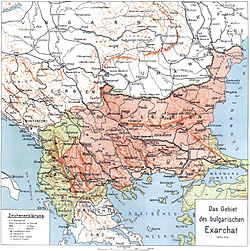
Back Български милет Bulgarian Millet Bulgaria ID Millet bulgaro Italian Бугарски милет Macedonian Mileti bullgar Albanian



Bulgarian Millet (Turkish: Bulgar Milleti) was an ethno-religious and linguistic community within the Ottoman Empire from the mid-19th to early 20th century.
The semi-official term Bulgarian Millet, was used by the Sultan for the first time in 1847, and was his tacit consent to a more ethno-linguistic definition of the Bulgarians as a nation. This resulted in the rise of a Bulgarian St. Stephen Church in the Ottoman capital Constantinople in 1851. Officially as a separate Millet in 1860 were recognized the Bulgarian Uniates, and then in 1870 the Bulgarian Orthodox Christians (Eksarhhâne-i Millet i Bulgar).[1] At that time the classical Ottoman Millet-system began to degrade with the continuous identification of the religious creed with ethnic identity and the term millet was used as a synonym of nation.[2]
The establishment of the Bulgarian Exarchate in 1870, meant in practice official recognition of a separate Bulgarian nationality,[3][4] and in this case the religious affiliation became a consequence of national allegiance.[5] The founding of an independent church, along with the revival of Bulgarian language and education, were the crucial factors that strengthened the national consciousness and revolutionary struggle, that led to the creation of a Bulgarian nation-state in 1878.[6] The ideas of Bulgarian nationalism grew up in significance, following the Congress of Berlin which took back the regions of Macedonia and Thrace under Ottoman control. So the Bulgarian nationalist movement proclaimed as its aim the inclusion of most of Macedonia and Thrace under Greater Bulgaria.
At the eve of the 20th century a series of conflicts arose into Ottoman regions outside the Bulgarian principality between Greeks and Serbs from one side and Bulgarian Exarchists from another. The local Slavic villages became divided into followers of the Bulgarian national movement and the so-called grecomans and serbomans. After the Balkan Wars the Bulgarian millet was limited finally to the boundaries of the Bulgarian state, despite the nominally much larger previous territory of the Bulgarian Exarchate.[7]
- ^ Evolutionary Theory and Ethnic Conflict Praeger Series in Political Communication, Patrick James, David Goetze, Greenwood Publishing Group, 2001, ISBN 0-275-97143-0, pp. 159–160.
- ^ Nationalist Exclusion and Ethnic Conflict: Shadows of Modernity, Andreas Wimmer, Cambridge University Press, 2002, ISBN 0-521-01185-X, pp. 171–172.
- ^ A Concise History of Bulgaria, R. J. Crampton, Cambridge University Press, 2005, ISBN 0-521-61637-9, p. 74.
- ^ The Making of a Nation in the Balkans: Historiography of the Bulgarian Revival, Rumen Daskalov, Central European University Press, 2004, ISBN 963-9241-83-0, p. 1.
- ^ Stefan Stambolov and the Emergence of Modern Bulgaria, 1870–1895, Duncan M. Perry, Duke University Press, 1993, ISBN 0-8223-1313-8, p. 7.
- ^ Dale F. Eickelman and Simeon Evstatiev as ed. (2022) Islam, Christianity, and Secularism in Bulgaria and Eastern Europe. Brill; ISBN 9789004511569, pp. 5-6.
- ^ Tomasz Kamusella (2018) Ethnic Cleansing During the Cold War. The Forgotten 1989 Expulsion of Turks from Communist Bulgaria. Taylor & Francis, ISBN 9781351062688, p. 192.
© MMXXIII Rich X Search. We shall prevail. All rights reserved. Rich X Search